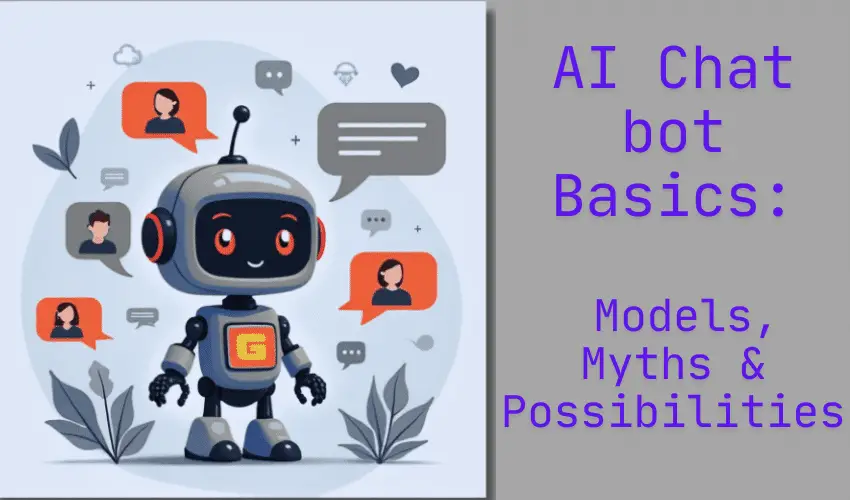Looking to Create Your Own Virtual Assistant?
AI chatbots have transformed customer service, business communications, and personal productivity. This guide demystifies chatbots—explaining the difference between rule-based and AI-powered bots, common myths, top AI models, and how to get started.
What is an AI Chatbot?
An AI chatbot is a software application that simulates conversations with users via text or voice. Using artificial intelligence and natural language processing (NLP), modern chatbots understand questions, interpret meaning, and provide intelligent responses—often feeling like you’re chatting with a real person.
Where Are Chatbots Used?
- Customer support on websites
- Virtual assistants (like Alexa, Siri)
- Messaging apps (WhatsApp, Telegram)
- E-commerce, banking, healthcare, and more
How Chatbots Work: Rule-Based vs. AI-Powered
Understanding the two main types of chatbots helps you choose the right technology for your needs.
| Feature | Rule-Based Chatbots | AI-Powered (Conversational) Chatbots |
|---|---|---|
| Response Logic | Predefined rules ("if-then") | Learns from data, understands language |
| Language Ability | Limited to scripts/keywords | Understands context, nuance, user intent |
| Flexibility | Rigid, hard to scale | Adapts, improves with more use |
| Examples | FAQ bots, menu-driven bots | GPT, Dialogflow, Rasa |
Rule-Based Chatbots
- Follow scripts: Respond only as programmed
- Great for: Simple FAQs or workflows
- Easy to build, but can’t handle unexpected questions
AI-Powered Chatbots
- Use machine learning/NLP to “understand” inputs
- Can answer: Complex, open-ended questions
- Learn and improve from user interactions
Key Point:
If your chatbot only needs to answer predictable questions ("What are your hours?"), go rule-based. For real conversations, use AI-powered bots.
Popular AI Models for Chatbots
Building an AI chatbot is easier than ever, thanks to powerful, ready-to-use models. Here are the most popular:
1- GPT (OpenAI)
- Type: Large language model (Generative Pre-trained Transformer)
- Strengths: Generates human-like responses, understands context, handles many topics
- Ideal for: Smart customer support bots, content creation assistants, Q&A bots
- Popular platforms: ChatGPT, OpenAI API
2- Dialogflow (Google)
- Type: NLP-powered chatbot framework
- Strengths: Easy to create conversational interfaces, supports multiple languages and voice inputs, integrates with Google Cloud
- Ideal for: Businesses needing multichannel, multilingual bots on websites, messaging apps, smart devices
3- Rasa
- Type: Open-source conversational framework
- Strengths: Full control over data and customization, on-premises deployment, supports complex integrations
- Ideal for: Enterprises with privacy needs, sophisticated workflows, or unique requirements
- Microsoft Bot Framework
- Type: Modular bot-building SDK
- Strengths: Integrates well with Microsoft services, supports multiple channels (Teams, Skype, etc.)
- Ideal for: Businesses using Microsoft products and cloud services
4- IBM Watson Assistant
- Type: AI chatbot service with NLP
- Strengths: Deep customization, enterprise security, data analytics
- Ideal for: Regulated industries or large-scale deployments
Myths About AI Chatbots
- Myth: “AI bots are always smarter.”
Reality: A simple rule-based bot might be best for specific cases. - Myth: “Training an AI chatbot is too hard.”
Reality: Pretrained models like GPT and platforms like Dialogflow make it easy for beginners. - Myth: “All bots are AI-powered.”
Reality: Many bots are still script-based.
How to Choose the Right Chatbot Model
- Simple, repetitive tasks? Use a rule-based chatbot.
- Need to handle open-ended, complex conversations? Use GPT, Dialogflow, or Rasa.
- Want to keep data private? Open-source Rasa or on-premises options work best.
- Building on a tight budget? Start with cloud-based APIs—OpenAI and Dialogflow often offer free tiers.
Final Thoughts
AI chatbots are changing how we interact with technology. With models like GPT, Dialogflow, and Rasa, anyone can now build a smart assistant—no advanced coding required. Consider your use case and business needs, and choose the model that gives you the right blend of accuracy, flexibility, and ease of use.
🚀 Try Linux Servers with $100 Free Credit!
Exclusive deals just for you—grab your $100 credit and try premium Linux hosting:
